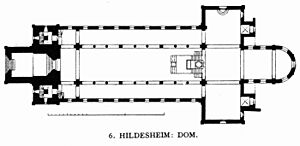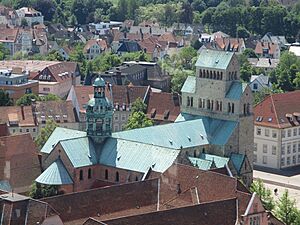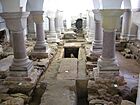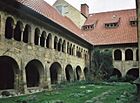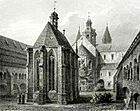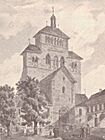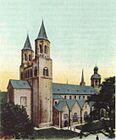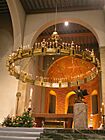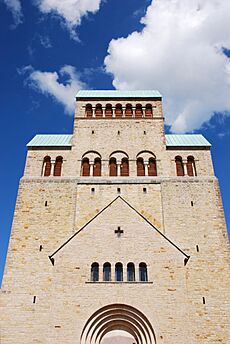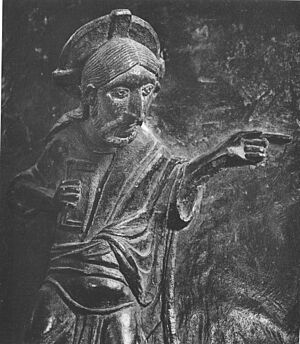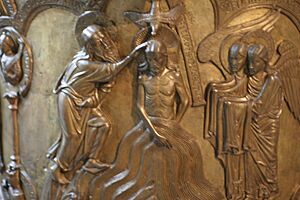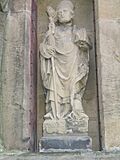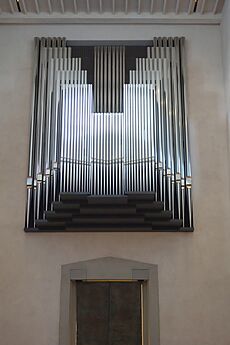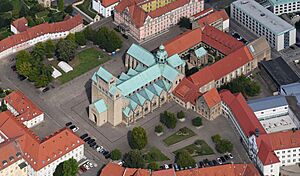Hildesheim Cathedral facts for kids
Quick facts for kids Hildesheim Cathedral |
|
|---|---|
| The Cathedral of the Assumption of Mary | |
|
Hildesheimer Dom
|
|
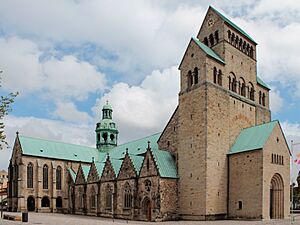
Northwest view of Hildesheim Cathedral
|
|
| 52°08′56″N 9°56′50″E / 52.14889°N 9.94722°E | |
| Location | Hildesheim |
| Country | Germany |
| Denomination | Roman Catholic |
| History | |
| Status | Active |
| Dedication | Assumption of Mary |
| Architecture | |
| Functional status | Cathedral |
| Architectural type | basilica |
| Style | Romanesque (original) Gothic (side chapels and northern paradise) Baroque (crossing tower) |
| Groundbreaking | 815 (Chapel of St. Mary) 872 (St. Mary's Cathedral) |
| Specifications | |
| Length | 80 m (262 ft 6 in) |
| Width | 44 m (144 ft 4 in) |
| Height | 20 m (65 ft 7 in) |
| Number of spires | 1 |
| Spire height | 41 m (134 ft 6 in) |
| Bells | 12 |
| Tenor bell weight | 8686kg |
| Administration | |
| Diocese | Diocese of Hildesheim |
Hildesheim Cathedral, also known as St. Mary's Cathedral, is a very old Roman Catholic church in Hildesheim, Germany. It is the main church for the Diocese of Hildesheim. Since 1985, this cathedral has been a World Cultural Heritage site recognized by UNESCO. It shares this honor with the nearby St. Michael's Church. Both are famous for their amazing art and Romanesque style.
The cathedral was built between 1010 and 1020. It has a special design with two rounded ends, which was common for buildings from the Ottonian Romanesque period. Inside, you can find incredible artworks. These include bronze pieces made during the time of Bishop Bernward, like the famous Bernward Doors and Bernward Column. The cathedral also has two large, beautiful wheel chandeliers: the Hezilo chandelier and the Azelin chandelier.
Over the centuries, the cathedral was updated and expanded. However, it was almost completely destroyed during an air raid on March 22, 1945, during World War II. It was rebuilt from 1950 to 1960. A big renovation started in 2010, making sure the building and its treasures were preserved. Some of its artworks were even shown at the Metropolitan Museum of Art in New York. The cathedral officially reopened on August 15, 2014.
Contents
History of Hildesheim Cathedral
Building the Cathedral
The Diocese of Hildesheim was created in 815. Soon after, a small chapel dedicated to St. Mary was built where the main part of the cathedral stands today. Bishop Gunthar, who was in charge from 815 to 834, built a small church next to it. This church was the first cathedral and where the first four bishops were buried.
The main cathedral we see today was built in 872 under Bishop Altfrid. It was designed as a cross-shaped church with three aisles and a two-story entrance area. This style is typical of Ottonian architecture. In 1046, a big fire damaged the building. Bishop Azelin planned a new, larger church, but his successor, Hezilo of Hildesheim, decided to rebuild on the old foundations. He used the parts of the walls that were still standing.
The cathedral was updated many times until the late 1300s, but its basic shape stayed the same. Some parts, like the side chapels, were added in the Gothic style. The tower above the center of the church was added in the Baroque style. In the 1800s, the original entrance was replaced with a new one that looked like old Romanesque buildings. This new entrance stood until 1945.
Cathedral School and Library
The Hildesheim Cathedral School was a very important school during the Ottonian and Salian periods in Germany. It had rooms in the cloisters, which are covered walkways around a courtyard. The cathedral's library, which started in 815, is the oldest library in Northern Germany.
Destruction and Rebuilding
During the air raids on Hildesheim in World War II, the main part of the cathedral was almost completely destroyed. Only the entrance area and outer walls remained. The Gothic Anne's Chapel, built in 1321 in the cathedral courtyard, was mostly unharmed. Hildesheim Cathedral was the only cathedral in Germany that needed to be completely re-dedicated after being rebuilt. This happened on March 27, 1960.
The rebuilding took place between 1950 and 1960. The goal was to make it look more like its early Romanesque style, rather than the Baroque additions. For example, the upper stories and side towers added to the entrance in 1840 were not put back. The entrance was rebuilt to look more like its original medieval design.
The reconstruction faced challenges, including a disagreement between the Diocese of Hildesheim and the state of Lower Saxony about who should pay for it. They reached an agreement in 1957.
Renovations from 2010 to 2014
A major renovation of the cathedral began in January 2010. This was the first big update since 1960. The floor was lowered back to its original level. The famous Hezilo chandelier and Azelin chandelier were put back in their original places. The Bernward Doors were also reinstalled to face outwards, as they were meant to be. A special burial place for bishops was also created.
The cathedral was closed on January 10, 2010, for the work. During this time, the basilica of St. Godehard served as the main church. This renovation was the largest church construction project in Germany at the time. The cathedral officially reopened on August 15, 2014. This date also marked the start of the Diocese's 1200-year celebration.
The Thousand-Year Rose
The cathedral is famous for the "Thousand-year Rose" (German: Tausendjähriger Rosenstock). This rose bush grows on the outside wall of the church, in the courtyard. No one knows its exact age, but a legend says it dates back to 815. It's a very important symbol for Hildesheim. People believe that as long as the rose bush blooms, Hildesheim will be successful.
The legend tells that Emperor Louis the Pious was hunting and needed to hold a church service. He hung a special box with holy items from a wild rose bush. After the service, he couldn't remove the box. He took this as a sign that the new bishopric should be built right there, dedicated to St. Mary, whose symbol is the rose.
We know for sure that the rose bush has been there for at least 400 years. When the cathedral was bombed in 1945, the rose bush above ground was destroyed. Only a burned stump remained. Everyone thought the rose was gone forever. But in the spring of 1945, 25 new shoots grew from the roots! By 1948, it had 122 flowers. New branches are marked with metal signs showing the year they appeared. It is thought to be the oldest living rose in the world.
Archaeological Discoveries
During the renovations from 2010 to 2014, archaeologists found the foundations of the first St. Mary's chapel from the 800s. This first church was small, about 6 by 6 meters, with a rounded end to the east. They also found the remains of the first altar. The foundations were made of very thick sandstone.
Even older discoveries were made to the west and south of the cathedral. Twenty graves were found. In August 2012, they uncovered the skeleton of a young woman who died around 800. She was buried with glass beads, which were likely part of a necklace, and a small knife. This was the oldest complete burial ever found at Hildesheim Cathedral.
Art and Treasures Inside the Cathedral
Hildesheim Cathedral is home to many incredible artworks. These include the world-famous bronze doors, known as the Bernward Doors. They show scenes from the Bible. There's also a bronze column, the Bernward Column, which shows scenes from the life of Jesus. These bronze pieces were made in the early 1000s for Bishop Bernward of Hildesheim.
The cathedral also has four important Romanesque wheel chandeliers. The two largest are the Hezilo chandelier and the older Azelin chandelier. Another important piece is the Ringelheim Crucifix, a wooden cross made around the year 1000.
Other treasures include:
- The shrine of St. Epiphanius of Pavia, from the early 1100s.
- The shrine of St. Godehard in the crypt, from around 1140.
- The Reliquary of Mary and the Crosses of Bernward. These and other beautiful items are displayed in the Hildesheim Cathedral Museum.
- A bronze eagle lectern from around 1220.
- The late Romanesque bronze baptismal font from 1225.
- The Gothic Inkpot Madonna, a statue of Mary.
- An apse cross, which legend says has a base made from the core of the Irminsul, an ancient holy tree.
Many of these religious items were shown at the Metropolitan Museum of Art in New York City until January 5, 2014, during the cathedral's renovations.
-
Statue of Bishop Godehard
Organs of the Cathedral
The cathedral has had organs since the 1300s. The first large organ was built around 1616/17. It had 31 stops, which are different sets of pipes that make various sounds. This organ was rebuilt and expanded over time. Sadly, it was destroyed in the air raid on March 22, 1945.
A new organ was built in 1960 with 52 stops. It was later expanded to 66 stops. In 2014, a brand new main organ was installed. It has 77 stops and uses some parts from the previous organ. There is also a smaller organ with 16 stops located in the left aisle. Both organs can be played from two identical control panels.
Cathedral Bells
Before World War II, the cathedral had over sixteen bells. Most of them were destroyed or damaged during the war. Only two bells could be reused: the Apostolica bell from 1765 and the Nikolaus bell from 1766.
After the war, in 1960, five new bells were made and installed in the west tower along with the Apostolica bell. The goal was to create a set of 12 bells, but only six were made at first.
During the 2010–2014 renovation, the bell collection was expanded to 12 bells, as originally planned. Six new bells were cast in 2013. These new bells are named after important figures in the Diocese of Hildesheim. For example, one bell is named for Bishop Altfrid, who helped build the cathedral. Another is named for Hedwig of Silesia, who is a patron saint for refugees.
The Cantabona bell, cast in 1960, is the second largest bell in Lower Saxony.
World Heritage Site Status
Hildesheim Cathedral was recognized as a World Heritage Site by UNESCO in 1985. This means it is considered very important for all of humanity. It shares this status with the nearby St. Michael's Church.
Reopening Ceremony
On August 15, 2014, the cathedral officially reopened after its big restoration. Bishop Norbert Trelle opened the famous Bernward Doors and entered the cathedral. Many other important guests, including bishops and politicians, joined him. Bishop Trelle spoke about the church living for the future while remembering its past. He also mentioned the burning of churches in Syria, highlighting the contrast with the cathedral's reopening. The restoration brought the cathedral closer to its original medieval look, removing later additions and restoring the old floor level. A new altar was also created for the reopening.
Location of the Cathedral
Hildesheim Cathedral is located in the southern part of Hildesheim's city center, on a small hill called Domhügel (Cathedral's Hill). The main entrances are on the south and north sides. The Roemer- and Pelizaeus-Museum, which is a famous museum, is very close to the cathedral on the west side. Around the hill, there is a wall that used to protect the cathedral area.
To the north of the hill is St. Michael's Hill, and to the northeast is downtown Hildesheim. To the west is the River Mühlengraben, which flows into the Innerste River. Near the cathedral, you can find the former government building, the Bishop's office, a school called Gymnasium Josephinum, and the city's Labour Court.


